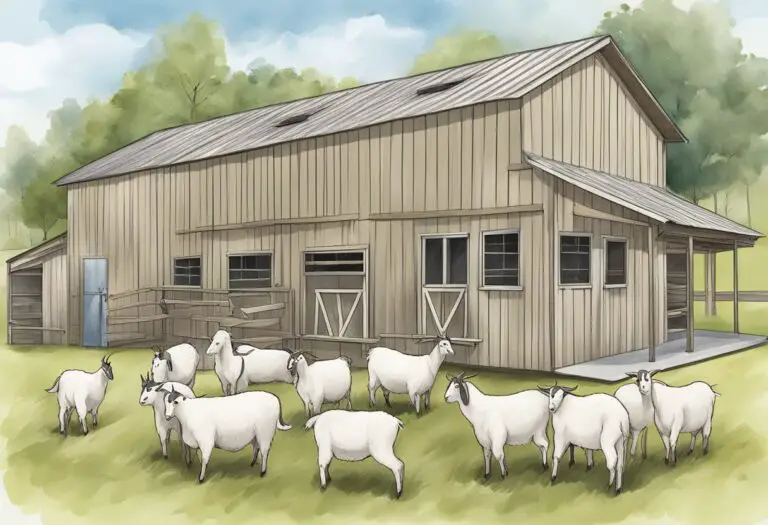When to Clean a Goat Barn: Tips and Guidelines
When it comes to raising goats, keeping their living quarters clean is essential for their health and well-being. A clean barn not only prevents the buildup of harmful bacteria and parasites but also helps to maintain a comfortable and stress-free environment for the animals. However, determining how often to clean a goat barn can be a bit tricky, as it depends on several factors.
One of the primary considerations when deciding how often to clean a goat barn is the number of animals housed within it. A larger herd will produce more waste and require more frequent cleaning than a smaller one. Additionally, the age and health of the goats can also impact the cleaning schedule. Younger or sick animals may require more frequent cleaning to prevent the spread of disease. The type of bedding used, as well as the ventilation and humidity levels in the barn, can also play a role in determining how often it needs to be cleaned.
Determining the Cleaning Frequency

Keeping a goat barn clean is essential to maintaining the health and well-being of the animals. However, determining the frequency of cleaning can vary depending on several factors. Here are some things to consider when determining how often to clean a goat barn.
Assessing Barn Use
The frequency of cleaning a goat barn will depend on how often it is used. A barn that is used daily will require more frequent cleaning than one that is used less often. Additionally, the number of goats in the barn will also impact the frequency of cleaning. The more goats in the barn, the more often it will need to be cleaned.
Observing Health and Behavior
Observing the health and behavior of the goats can also help determine the frequency of cleaning. If the goats are healthy and well-behaved, the barn may not need to be cleaned as often. However, if the goats are sick or have diarrhea, the barn will need to be cleaned more frequently to prevent the spread of disease.
Considering Seasonal Changes
The frequency of cleaning a goat barn may also vary depending on the season. During the summer months, when the weather is hot and humid, the barn may need to be cleaned more often to prevent the buildup of moisture and bacteria. In the winter, when the weather is cold and dry, the barn may not need to be cleaned as often.
In summary, determining the frequency of cleaning a goat barn will depend on several factors, including barn use, goat health and behavior, and seasonal changes. By assessing these factors, goat owners can develop a cleaning schedule that will keep their animals healthy and comfortable.
Preparing for Cleaning

Before cleaning a goat barn, it is important to prepare the necessary supplies and plan for waste disposal. This will ensure that the cleaning process is efficient and effective.
Gathering Necessary Supplies
The following supplies are necessary for cleaning a goat barn:
- Gloves
- Face mask
- Broom and dustpan
- Scrub brush
- Bucket
- Cleaning solution
- Water hose
- Shovel
It is important to wear gloves and a face mask to protect against harmful bacteria and dust. The broom and dustpan can be used to sweep up loose debris, while the scrub brush and cleaning solution can be used to clean surfaces. The water hose can be used to rinse surfaces and the shovel can be used to remove waste.
Planning Waste Disposal
Waste disposal is an important aspect of cleaning a goat barn. The following steps should be taken to properly dispose of waste:
- Separate solid waste, such as manure and bedding, from liquid waste.
- Place solid waste in a designated area for composting or disposal.
- Dispose of liquid waste in an appropriate manner, such as a septic system or designated waste disposal area.
It is important to follow local regulations and guidelines for waste disposal to ensure that it is done in a safe and environmentally friendly manner. By properly preparing for cleaning and waste disposal, the goat barn can be kept clean and healthy for the goats.
Executing the Cleaning Process

Cleaning a goat barn is a crucial task that must be done regularly to ensure the health and well-being of the animals. The following subsections outline the steps involved in executing the cleaning process.
Removing Bedding and Waste
The first step in cleaning a goat barn is to remove all the bedding and waste material from the stalls. This includes any soiled straw, hay, or wood shavings. The bedding and waste should be disposed of properly, either by composting or by taking it to a designated waste disposal site.
Cleaning and Disinfecting Surfaces
Once the bedding and waste have been removed, the next step is to clean and disinfect all surfaces in the barn. This includes the floors, walls, and any equipment or tools used in the barn. A mixture of water and disinfectant should be used to clean all surfaces thoroughly. It is important to follow the manufacturer’s instructions for dilution and application of the disinfectant.
Addressing Spillage and Leaks
During the cleaning process, it is important to address any spillage or leaks that may have occurred in the barn. This includes cleaning up any spilled feed or water, as well as repairing any leaks in the water or feed systems. This will help to prevent the growth of bacteria and other harmful organisms in the barn.
Overall, executing the cleaning process in a goat barn is an important task that should be done regularly. By following these steps, goat owners can ensure the health and well-being of their animals and maintain a clean and safe environment for them to live in.
Maintaining a Clean Environment

Keeping a clean environment is crucial for the health and well-being of your goats. A clean barn not only prevents the spread of diseases but also ensures that your goats are comfortable and content. Here are some tips to help you maintain a clean environment for your goats.
Daily Maintenance Practices
Daily maintenance practices are essential to keep your goat barn clean. These practices include:
- Sweeping – Sweeping the barn floor daily will help remove any debris, dirt, or dust that may have accumulated. This practice will also help prevent the buildup of harmful bacteria and parasites.
- Removing Manure – Removing manure from the barn daily is essential. Manure can attract flies and other pests that can spread diseases to your goats. You can use a pitchfork or a shovel to remove the manure.
- Feeding – Feeding your goats in a clean area will help prevent the spread of diseases. Use clean feeders and waterers, and make sure to remove any leftover feed.
Implementing a Regular Cleaning Schedule
Apart from daily maintenance practices, it is essential to implement a regular cleaning schedule to keep your goat barn clean. Here are some tips to help you implement a regular cleaning schedule:
- Deep Cleaning – Deep cleaning the barn once a week is essential. This practice involves removing all the bedding, sweeping the floor, and disinfecting the barn. You can use a disinfectant spray or a mixture of vinegar and water to disinfect the barn.
- Bedding – Using clean and dry bedding is essential to keep your goat barn clean. Replace the bedding once a week or more frequently if needed.
- Ventilation – Proper ventilation is crucial to maintain a clean environment in the barn. Make sure that the barn has enough ventilation to prevent the buildup of harmful bacteria and parasites.
By following these tips, you can maintain a clean environment for your goats. A clean barn will not only keep your goats healthy but also ensure that they are happy and comfortable.
Health and Safety Considerations

Protective Equipment for Handlers
When cleaning a goat barn, it is important to prioritize the safety of the handlers. Handlers should always wear protective equipment such as gloves, boots, and masks to protect themselves from potential hazards. Gloves should be made of a durable material that can withstand the wear and tear of cleaning and should be changed regularly to prevent the spread of disease. Boots should be waterproof and slip-resistant to prevent falls and injuries. Masks should be worn to protect handlers from inhaling dust and other airborne particles.
Proper Ventilation
Proper ventilation is essential when cleaning a goat barn. Poor ventilation can lead to the buildup of harmful gases such as ammonia and carbon dioxide, which can cause respiratory problems for both the goats and handlers. Handlers should ensure that the barn is well-ventilated by opening windows and doors and using fans to circulate air. If the barn is poorly ventilated, handlers should consider wearing respiratory protection to prevent inhalation of harmful gases.
In summary, handlers should always prioritize their safety when cleaning a goat barn by wearing protective equipment and ensuring proper ventilation. By following these guidelines, handlers can effectively clean the barn while minimizing the risk of injury or illness.
Post-Cleaning Procedures

Inspecting the Barn
After cleaning the goat barn, it is important to inspect the area thoroughly to ensure that everything is in order. This includes checking for any damages, cracks, or holes in the walls, floors, or ceilings that could allow predators or pests to enter. It is also important to check the ventilation system and make sure that it is functioning properly.
Inspecting the barn also involves checking the condition of the bedding and removing any wet or soiled bedding. This will help to prevent the growth of bacteria and mold, which can be harmful to the goats’ health. It is also recommended to add fresh bedding to the barn after cleaning to keep the goats comfortable and clean.
Restocking Supplies
Restocking supplies is an essential post-cleaning procedure that should not be overlooked. This includes replenishing the hay, water, and feed supplies, as well as cleaning and disinfecting any equipment used during the cleaning process.
It is important to ensure that the hay is stored properly to prevent contamination and spoilage. Water should be fresh and clean, and the feed should be free of mold or any other contaminants. Cleaning and disinfecting equipment will help to prevent the spread of disease and keep the barn clean and hygienic.
By following these post-cleaning procedures, goat owners can ensure that their goats are healthy, comfortable, and safe in their barn.







